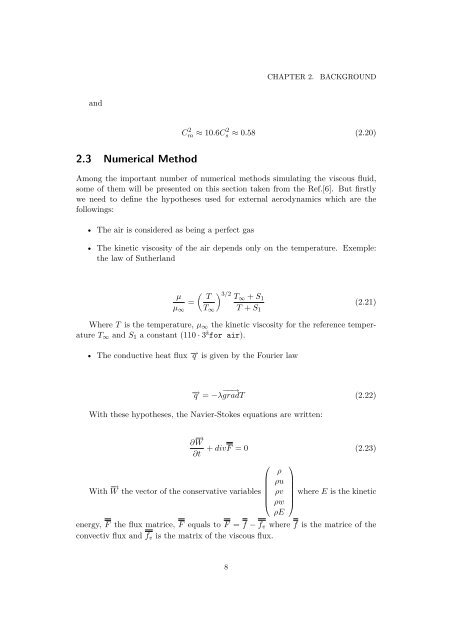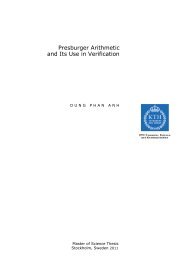Synthetic Inflow Condition for Large Eddy Simulation (Synthetic - KTH
Synthetic Inflow Condition for Large Eddy Simulation (Synthetic - KTH
Synthetic Inflow Condition for Large Eddy Simulation (Synthetic - KTH
You also want an ePaper? Increase the reach of your titles
YUMPU automatically turns print PDFs into web optimized ePapers that Google loves.
and<br />
2.3 Numerical Method<br />
CHAPTER 2. BACKGROUND<br />
C 2 m ≈ 10.6C 2 s ≈ 0.58 (2.20)<br />
Among the important number of numerical methods simulating the viscous fluid,<br />
some of them will be presented on this section taken from the Ref.[6]. But firstly<br />
we need to define the hypotheses used <strong>for</strong> external aerodynamics which are the<br />
followings:<br />
• The air is considered as being a perfect gas<br />
• The kinetic viscosity of the air depends only on the temperature. Exemple:<br />
the law of Sutherland<br />
µ<br />
µ∞<br />
� �3/2 T T∞ + S1<br />
=<br />
T∞ T + S1<br />
(2.21)<br />
Where T is the temperature, µ∞ the kinetic viscosity <strong>for</strong> the reference temperature<br />
T∞ and S1 a constant (110 · 3 ž <strong>for</strong> air).<br />
• The conductive heat flux −→ q is given by the Fourier law<br />
−→ q = −λ −−→<br />
gradT (2.22)<br />
With these hypotheses, the Navier-Stokes equations are written:<br />
∂ −→ W<br />
∂t<br />
With −→ ⎜<br />
W the vector of the conservative variables ⎜<br />
⎝<br />
+ divF = 0 (2.23)<br />
⎛<br />
ρ<br />
ρu<br />
ρv<br />
ρw<br />
ρE<br />
⎞<br />
⎟ where E is the kinetic<br />
⎟<br />
⎠<br />
energy, F the flux matrice, F equals to F = f − fv where f is the matrice of the<br />
convectiv flux and fv is the matrix of the viscous flux.<br />
8

















